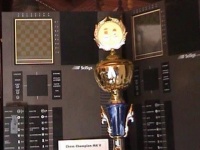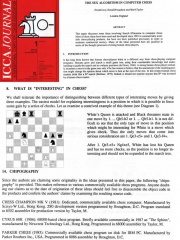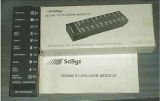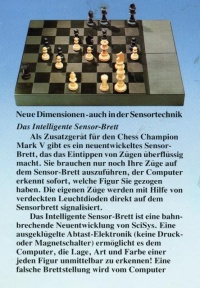Broughton, David
David C. Broughton, (*1934 - † 02. Februar 2017)

war ein britischer Computerberater und Computerschachprogrammierer. Sein erstes Schachprogramm Vega, geschrieben auf der Z80 North Star Horizon Maschine, hatte den 2. Platz hinter Sargon beim 2. PCW-MCC-Turnier in London im November 1979 erreicht, und er wurde bald von David Levy und Kevin O'Connell angeworben, um für ihre Firmen Philidor Software und seit 1981 Intelligent Software zu arbeiten. Er arbeitete an dem Projekt Philidor, dessen 8086-Portierung zu Parker Chess und zum SciSys Chess Champion Mark V führte. Broughtons Arbeit für den Mark V erfolgte in Form von Z80-Assembler. Da der Mark V einen 6502-Prozessor hatte, musste das Programm umfangreich übersetzt und umgeschrieben werden. Das Mark V-Programm ist also sowohl Mark Taylor als auch David Broughton zu verdanken, obwohl David Levy das Mark V bekanntlich Taylor zuschreibt. David Broughton starb am 02. Februar 2017. Seine Frau Dina starb erst kürzlich, am 10. März 2019.
Interview with David Broughton, Feb. 2006 by 'hard
Wiki / 'hard: In all written publications David Levy was named as the programmer of some chess units, especially the Scisys Mark V. I had my doubts and while doing some research in the internet, your name popped up as the man behind the Mark V program

David Broughton: I worked on the Chess Champion Mark V (manufactured by Scisys) under the chess direction of David Levy and Kevin O'Connell. David Levy was not a programmer: he was the chess expert who provided some of the heuristics. The program was developed by me using my own home computer which had a Z80 processor but the final product had to use a 6502 CPU. The conversion was done by Mark Taylor. The openings book was provided by David Levy.
Wiki: Why was it necessary to convert your Z80 program to the 6502? Scisys could have made a Z80 circuit board. At that time many chess computers - like the Fidelity CC series or the Novag Savant were based on a Z80 cpu.
D.B.: This question was one I had asked several times but for some reason Scisys seemed to be committed to the 6502 and would not change their mind. The 6502, however, was easier to engineer -- it required simpler power supplies and had other hardware advantages.
Wiki: You started 1978 with chess programming. How much time did you spend for creating the 1979 amateur [PCW] winner?
D.B.: About a year, using a North Star Horizon Z80 home computer, though I had done lots of planning for the program before that, reading up other work on the subject and attending a conference in Edinburgh on the subject of chess programming. That program was called Vega.
Wiki: Is there an essential difference in the program to the later Mark V?
D.B.: The Mark V was quite different from Vega.
Wiki: The Z80 cpu was very common at that time. Did you release your chess software for some home computers? If not, any special reason why?
D.B.: No. I was prepared to but got involved with the Mark V project almost straight after my PCW win.
Wiki: What kind of chess programmer are you? Did you prefer the selective or brute force approach? What basic knowledge (papers) about chess programming did you use?

D.B.: David Levy's ideas were very much on the lines of an intelligent selective search and I agreed with him. Implementing the ideas was more difficult but we read all the literature that was available at the time and I tested out many different approaches. It boiled down to a compromise between speed and positional intelligence because the positional evaluations consumed a lot of CPU time. I devised a scheme of selective search that was very successful. The depth of search was controlled more in relation to the kind of moves made up to that point in the tree than by an iterative search to a series of fixed depths. It was called the SX algorithm. It was written up in a journal (the name of which escapes my memory at present -- was it "Advances in Computer Chess"?) with the title "The SEX Algorithm in Computer Chess" by David Levy, David Broughton and Mark Taylor. [Wiki: It was in the ICCA-Journal, Volume 12/1 1989 (page 10-21). See parts from it on the left.].
Wiki: The Mark V was not only very well playing, he was also the best chess puzzle solver for many years. What was his secret?
D.B.: Simply efficient programming to a fixed depth of search and cutting out all material and positional evaluations other than the king value.
Wiki: Beside the Mark V, are there other dedicated chess computers (Mark VI. ?) with your program inside? There are rumors, that the Milton Bradley has a program like the Mark V.

D.B.: Unless the Mark V has been disassembled, I doubt that anything of significance has been used elsewhere except the published SX Algorithm.
I went on to produce a program for Parker Brothers of the USA for the IBM-PC when it emerged in 1981. It was called Philidor by David Levy but simply "Chess" by Parker Brothers. During development I play lots of test games with my program and one of them that I lost was sufficiently of interest to be published in the magazine "Chess" in July 1981 with my own commentary that I sent to David Levy in private. I'm probably the lowest ELO rated player (1700) to have a game published in that magazine!
Wiki: Does it mean, that the later Mark VI Philidor module from 1983 was programed by someone else? Perhaps Mark Taylor, but based on your earlier work?

D.B.: I worked on the Mark VI as well as the Mark V. But the Mark VI, as I recall, was not as big an improvement over the Mark V that everyone hoped for: other chess programs had improved more than ours over the period between the two machines and the Mark VI was a disappointment.
Wiki: Can you remember some (technical) details about your chess projects? RAM/ROM size, cpu speed, book size, how many sold, etc.
D.B.: The 6502 CPU had 28 kbytes of memory, but I cannot remember how much of that was ram or rom; there must also have been some CMOS memory but I do not recall the details. I think the speed was not much faster than 4 MHz, which was the speed of the Z80 development machine. It had a substantial openings book but I have no figures.

Wiki: Scisys announced in 1981 the "natural playing board". IIRC the board should have piece recognition. What happened to this project?
D.B.: Yes, this was claimed to be an optional peripheral but it did not materialise. I don't know why it did not go into production. I did do some programming on such a board. I particularly liked the piece recognition. I programmed it at one time to allow the human player to move chess pieces in anticipation of the computer's reply move so that after the program had made its internal move it would not have to ask the human to move the piece (unless, of course, the human made the wrong choice) and could get on straight away in anticipating the opponent's reply, or even find that the human had already played its reply!
Wiki: When and why did you stop with chess programming? Are you still interested in computer chess and/or the dedicated units?
D.B.: I stopped programming chess computers when I was offered a more lucrative job in programming television effects. There was also, I have to admit, a feeling that I had reached the end of the techniques I knew about. At that time (c 1985) many new chess programs and machines were coming along that were far superior to any that I had produced and I felt the opposition was too far ahead of me.
Wiki: Can you share some pictures (or papers) from that time with the community? Showing you, the other pioneers, prototypes, circuit boards, software listing, hex dumps, the championships ... All is welcome!
D.B.: I've mentioned two items that were published. I have a few newspaper cuttings, that is all.
Wiki: David, thank you very much for your detailed answers. Do you allow me to put our interview into the Wiki? I would also like to leave there a photo, showing you today. I have attached one, which was taken from your journal of the "ISLE OF WIGHT PC USER GROUP". Is this OK?
D.B.: Yes, that is OK. I give my permission. All the best, David Broughton.
MY PROFILE by David Broughton
(taken from "ISLE OF WIGHT PC USER GROUP", MONTHLY JOURNAL, Issue 140 - July 2003)
Born in 1934, David spent his childhood in a small mining village in Yorkshire. After leaving school at age 14 he had an assortment of jobs from ophthalmic lens setting to the chemical analysis of metals before entering the RAF where he spent the first 9 months learning about electronics full time. This was a great career booster. On Leaving the RAF in 1957 he joined the BBC as a technical assistant and rose, after 20 years and lots of part-time education, to the status of an Electronics Design Engineer. On the introduction of computers at the BBC in 1962 David took a course in programming the Elliot 803 computer and got hooked on programming. The Elliot 803 weighed 594 kg without any peripherals and consumed 3.5 kW of power.
To learn more about computing David took a part-time degree course at London University to obtain an M.Sc. in Computer Science, gaining professional membership of the British Computer Society. He then set up a new section in BBC Engineering Designs Department providing a scientific computing service to electronic design engineers.
When home computers became affordable in 1978, David purchased a North Star Z80 computer running at 4 MHz for £2,500 (with a massive 32 Kbytes of memory!) and programmed it to play chess. This was a very advanced machine at the time. Communication was via the RS-232 serial port for keyboard input and display monitor output and it had a primitive disk operating system predating even CP/M. The floppy disks could store 180 Kbytes of data. The chess program was entered in the Computer Chess Competition at the Personal Computer World Show in September 1979, winning the top prize for an amateur entry of £1,500 which partly paid for the computer.
In 1980 David left the BBC to become a self-employed programmer and consultant, starting with chess machines for the commercial market. In 1981 his program won the World Microcomputer Chess Championship with the SciSys Mark V chess computer. He later worked for a company producing specialised video effects machines for the television broadcasting industry. These required complex mathematical equations to be solved in real time using very fast microprocessors. You often see the results when your TV picture rotates and zooms off into the distance, and similar effects.
